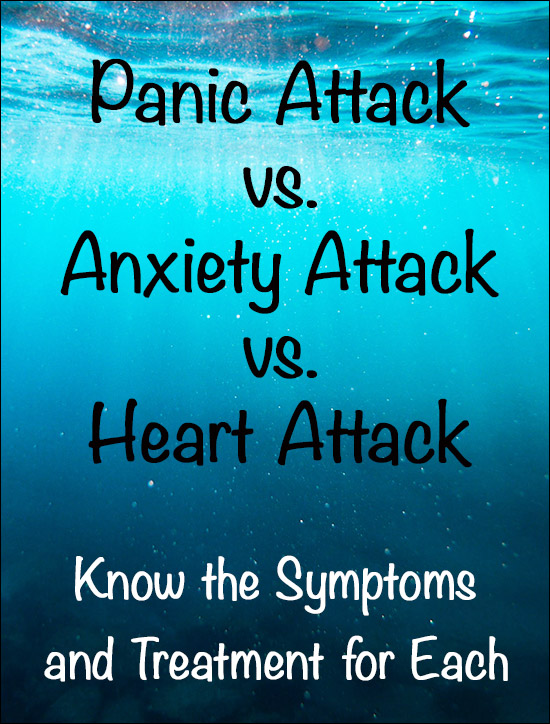Though panic attacks, anxiety attacks and heart attacks are three very different things, it’s not always easy to discern the sometimes subtle differences in symptoms while in the midst of any one of these events.
Seek immediate medical attention when experiencing sudden chest pain that spreads to other parts of the body, such as the jaw, arm or shoulder blades. If it is a heart attack, prompt treatment can save a person’s life.

- Nearly 800,000 people suffer a heart attack each year, according to the Centers for Disease Control and Prevention (CDC)
- Anxiety disorders affect an estimated 40 million adults in the U.S., making it the most mental illness in the country
- Around 6 million adults in the U.S. struggle with panic disorder, according to the Anxiety and Depression Association of America
Being aware of the differences in symptoms ahead of time, however, might help alleviate additional fear about what’s happening to a person’s body during a panic attack versus an anxiety attack versus a heart attack.
What are Typical Panic Attack Symptoms?
The onset of a panic attack is sudden, often creating an overpowering fear and intense physical pain.
The most common panic attack symptoms usually include:
- Chest pain
- Increased heart rate and a sense of feeling smothered
- Lightheadedness or dizziness
- Nausea
- Tremors, usually in the hands
- Tingling or numbness in the extremities
- Sweats or hot flashes
- Chills
- Feeling out of control or an impending sense of oncoming death
Generally, panic attacks last for about 20 to 30 minutes, with the peak intensity of the symptoms being around the 10 to 15-minute mark.
The American Psychological Association (APA), which publishes the Diagnostic and Statistical Manual of Mental Disorders (DSM-5), known as the “bible of psychiatry,” categorizes panic attacks as expected and unexpected.
Unexpected attacks happen without an apparent trigger, while expected attacks are suddenly brought on by an existing phobia.
Not everyone who has a panic attack has what the DSM-5 refers to as panic disorder, which comes with a different set of criteria as the Mayo Clinic reports.
How are Panic Attacks Diagnosed and Treated?
Diagnosis for panic attacks often involves an initial physical exam, including blood work, to rule out any physical causes, such as heart or thyroid disorders, that can mirror panic attack symptoms.
Treatment for panic attacks can include antidepressants and, in some cases, benzodiazepines, a class of sedatives that reduce the physical symptoms of anxiety.
These approaches are also often coupled with therapies like Cognitive Behavioral Therapy (CBT), which teaches people the relationship between their thought processes, emotions and behaviors.
Holistic treatment approaches for panic attacks include:
- Avoiding caffeine and alcohol
- Regular exercise
- Practicing mindful meditation techniques
- Healthy diet
- Good sleep habits
These are basic health tips that everyone should follow, but they’re highly recommended for those who are prone to panic attacks.
What are the Symptoms of an Anxiety Attack?
Anxiety is marked by excessive worry, fear and distress. It’s often related to an upcoming obligation, experience or event that a person considers highly stressful.
Unlike panic attacks, which happen suddenly, anxiety attacks are the culmination of hours, days, or even weeks of disproportionate fear and worry about an impending, stress-triggering event or perceived threat.
The symptoms of an anxiety attack are not necessarily as intense and severe as a panic attack, though they do tend to last longer. They can include some of the following:
- Inability to concentrate or focus
- Frequent restlessness
- Difficulty sleeping, leading to fatigue and exhaustion
- Mood swings, ranging from irritability to depression or excessive fear
- Dizziness
- Dry mouth
- Muscle pain or aches
- Chest pain
- Increased heart rate
- Shortness of breath
It is possible to experience a panic attack as a result of an ongoing, untreated anxiety attack.
There a number of factors that increases a person’s risk of anxiety attacks, such as experiencing or witnessing past trauma, substance abuse and addiction, other chronic medical conditions or a history of mental illness, both personally and genetically.
How are Anxiety Attacks Diagnosed and Treated?
Diagnosis and treatment for anxiety attacks is similar to that of panic attacks such as:
1. Physical Exam
First, a primary physician will likely conduct a physical exam to address any physical conditions that might be exacerbating symptoms of anxiety.
2. Psychological Evaluation
The next step is a psychological evaluation, which will include a discussion about symptoms and triggers that can sometimes help categorize the type of anxiety a person is battling.
3. Treating Related Conditions
Treating other chronic diseases or conditions, such as addiction, is vital if a person is to recover from anxiety attacks and related disorders.
4. Medication and Therapy
Medication, counseling and therapies like CBT are also incredibly effective, evidence-based treatments for learning to manage and overcome anxiety attacks.
5. Adopt a Healthy Lifestyle
Here again, a healthy lifestyle that includes regular exercise, meditation or relaxation techniques, good sleep habits and a nutritious diet are key.
What to do During a Panic or Anxiety Attack?
In the chaos and fear of a panic or anxiety attack, it’s important to be aware of what is happening and focus on breath control.
Difficulty breathing is very scary and, as a result, adrenaline can kick a person’s heart rate even higher making the attack all the more more distressing.
Taking slow, steady, deep breaths can help alleviate the crush of physical symptoms brought on by panic and anxiety attacks.
It’s important to then decide what are the best next steps for seeking help or continued treatment.
What are the Symptoms of a Heart Attack?
A heart attack is caused by a blockage, in one or more vessels leading to the heart, that interrupts blood flow to the vital organ.
The immediate symptoms of a heart attack are felt suddenly and can include:
- A heavy, weighted or squeezing pressure in the chest
- Pain that spreads to the arm, jaw, neck, should or back
- The intensity of the pain continues to worsen
- Shortness of breath
- Lightheadedness and dizziness
- Cold sweats
- Nausea or vomiting
- Fatigue or feeling tired
The fear a person experiences during panic, anxiety and heart attacks can make it difficult to know what exactly is happening, but there are subtle differences in the symptoms.
Heart attacks often occur after some amount of physical exertion, such as sex, climbing stairs or other physical taxing activities.
Another good indicator of whether or not a person is having a heart attack is the spread of pain to the arms, jaw, neck or back.
Chest pain during a heart attack feels more like the chest or heart is being squeezed.
With panic and anxiety attacks, the pain is often experienced as a sharp stab in the center of the chest.
If there is any doubt at all about what kind of attack a person is having, though, it’s best to call 9-1-1 for immediate medical attention.
A person can survive a heart attack, but ignoring the symptoms can be fatal.
How is a Heart Attack Diagnosed and Treated?
Emergency health care workers can typically diagnose a heart attack after checking a person’s vital signs and symptoms.
Immediate treatment for heart attacks can vary depending on a person’s history, health and age. These can include stents to unblock vessels to the heart and improve blood flow to coronary bypass surgery.
Panic attacks and anxiety attacks will not cause heart attacks, but there is evidence excessive stress and anxiety can increase a person’s risk for developing heart disease, the leading cause of heart attacks.
Treatment for a Heart Attack
After a hospital stay, heart attack survivors are generally prescribed some of the following:
- Blood thinners
- Blood pressure medications
- Statins to control cholesterol
- Nitroglycerin to treat chest pain and improve blood flow in severe, chronic cases
A lifestyle change is also necessary to avoid further heart attacks.
Similar to people who suffer panic and anxiety attacks, heart attack survivors are encouraged to follow these health guidelines:
- Quit smoking
- Limit alcohol intake
- Maintain a healthy weight
- Exercise regularly
- Eat a healthy diet
- Manage stress
- Get regular medical checkups
For people who have a relatively healthy lifestyle, the first onset of a panic attack, anxiety attack, or heart attack can be scary, and the first thought most people consider is they may be having a heart attack.
All three types of attacks share similarities, although the slight differences in symptoms and the nature of how quickly they arise and subside provide clues to the actual type of health issue they are experiencing.
Understanding the differences can help those get the proper medical attention needed to survive and overcome the symptoms.
Related:
Finding Anxiety Treatment Help
Self Care – Put Your Oxygen Mask On First
Is There a Difference Between Stress and Depression?
Stress Awareness Month: The Good, The Bad and The Treatable





